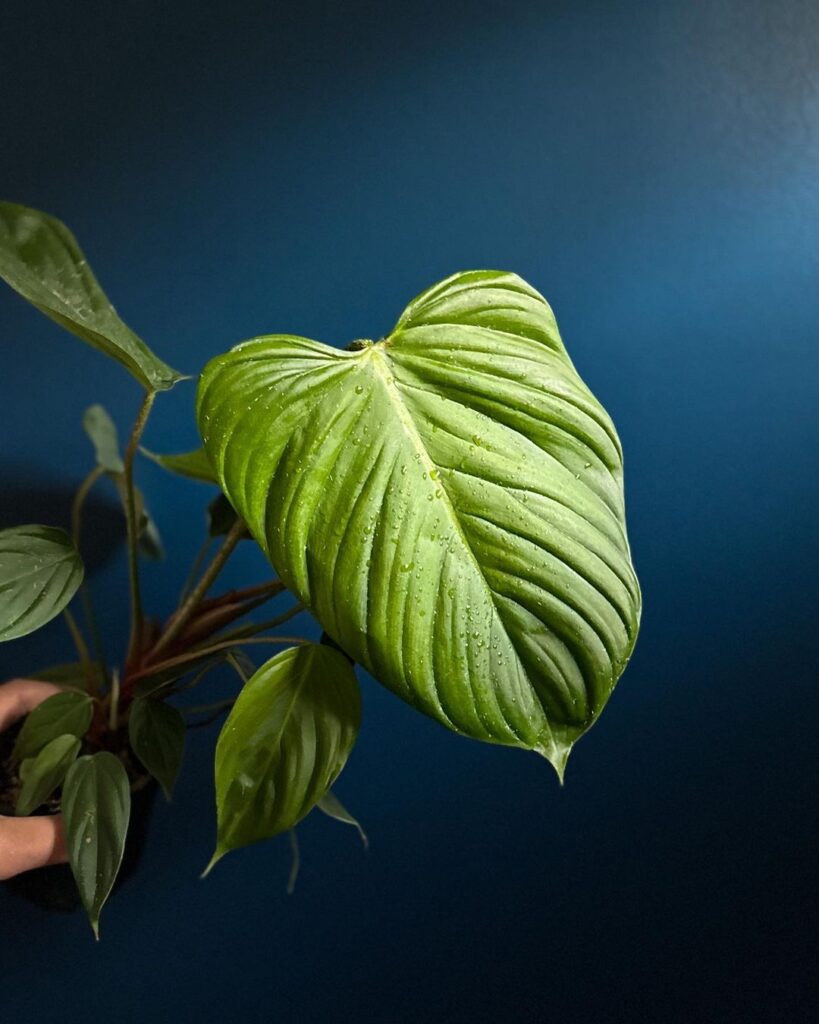Philodendron Fuzzy Petiole is a climbing species that flourishes in environments with high humidity, dappled sunlight, and warm temperatures.
Follow this easy Philodendron Fuzzy Petiole Growing and Care Guide to find the simple steps to nurture this exquisite plant and decorate your home with its natural charm.
Read: Philodendron Bloody Mary Care
Philodendron Fuzzy Petiole Information

The Philodendron Fuzzy Petiole is a tropical plant native to the rainforests of Central America, particularly Ecuador. In its natural habitat, you can find it growing abundantly on the forest floor, climbing trees and branches.
Although there are numerous philodendron species, making them sometimes challenging to distinguish, the Fuzzy Petiole resembles the Philodendron Nangaritense. However, there are notable differences between them. The Fuzzy Petiole has smaller, more heart-shaped leaves compared to the oblong leaves of the Philodendron Nangaritense. Regarding leaf appearance, the Fuzzy Petiole is more reminiscent of the Philodendron Gloriosum. Both of these philodendron varieties are low-maintenance tropical plants that can bring beauty to any room.
Propagating Philodendron Fuzzy Petiole
The most effective method to propagate the Philodendron Fuzzy Petiole is through stem cuttings.
- During the active growing season, select a stem with a few healthy leaves.
- At one end of the cutting, remove these leaves, as they contain crucial growth points or nodes that aid in root development later on.
- Next, dip the nodes of the cutting into a rooting hormone and prepare a pot with fresh soil that has adequate drainage holes at the bottom.
- Place the stem cutting in indirect sunlight and ensure that the soil remains consistently moist.
- If you feel resistance when lightly tugging the plant, it indicates that rooting has begun.
- Typically, you can expect the cutting to root within a span of 3-4 weeks.
- Once roots appear, you can continue caring for the plant as you would with an established Philo.
Alternatively, you have the option of rooting the cutting in water initially. When roots develop, move the cuttings to the soil.
Ideal Growing Conditions for Philodendron Fuzzy Petiole
Location
The Philodendron Fuzzy Petiole needs bright indirect light for 6-12 hours a day. Insufficient light results in smaller leaves and leggy vines, while excessive direct sun rays can cause leaf burn.
Placing the plant near an east-facing window provides the ideal lighting conditions for optimal growth. Once you find the right spot, minimal adjustments are needed for its well-being.
Soil
This plant is not demanding when it comes to soil type. Use for well-draining and nutrient-rich soil, typically found in pre-mixed indoor plant or house plant soils.
For better results, consider using organic coco coir instead of peat moss. Adding perlite can improve soil drainage and aeration. Watch for clumping and drainage speed when watering. Ensure the pot has a drainage hole for proper water flow.
Water
The Philodendron Fuzzy Petiole requires consistently moist soil but must not be overly soggy. Watering frequency depends on the season and placement.
In the growing season, water the plant deeply every 7-10 days, ensuring proper drainage. Wait for the top few inches of soil to dry out before watering again.
Reduce watering in winter, considering light and temperature conditions.
Temperature & Humidity
The ideal temperature for Philodendron Fuzzy Petiole ranges from 65-85 F, making them suitable for average household conditions near bright windows. Ensure frost protection if grown outdoors, as they have little to no frost tolerance. Warmer temperatures require more frequent watering.
Average household humidity is sufficient, but increasing it above 60% can accelerate growth. Enhance humidity by placing the plant near other plants, in a greenhouse-like setting, or using a humidifier.
Read: Dragon Tail Philodendron Care
Philodendron Fuzzy Petiole Care
Fertilizer
Fertilize Philodendron Fuzzy Petiole in the growing season with a dilute balanced liquid fertilizer (1/4 strength) every two weeks. Do not feed the plant in winter.
If you notice continuous growth across the year, apply worm castings or compost or 1/4 strength fertilizer as a top dressing during foliage growth.
TIP: Water the plant always after fertilizing.
Repotting
Philodendron fuzzy petiole needs to be repotted every two years in one size larger pot. Make sure to use fresh potting mix and give the plant a thorough watering after repotting.
Support
When grown as a houseplant in a pot, this plant typically reaches a height of a couple of feet. To encourage the plant to mature, it is advisable to provide it with something to climb on.
To support the growth of this plant, you can use a tall and slender moss pole in the pot by inserting it directly into the soil. Secure the plant to the pole by using a zip tie that is typically included with the moss pole. As the plant continues to grow, you can use vinyl plant tape to steadily fasten it to the pole, guiding its upward ascent.
Pests and Diseases
Philodendron fuzzy petioles are susceptible to various pests such as aphids, fungus gnats, spider mites, scale insects, and mealybugs. Quick treatment is necessary if an infestation occurs.
Additionally, inadequate plant care can lead to common diseases like root rot, leaf spot, and blight. It is important to be vigilant in preventing and addressing these issues.
Read: Philodendron Orange Marmalade Care
Toxicity
It is important to note that Philodendron plants are toxic, as all parts of the plant contain insoluble calcium oxalate crystals. Ingesting any part of the plant can result in discomfort, irritation, burning sensations in the mouth and throat, vomiting, diarrhea, and difficulty breathing. To ensure safety, it is crucial to exercise caution and keep Philodendron plants out of reach of children and pets.



